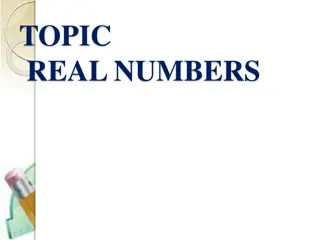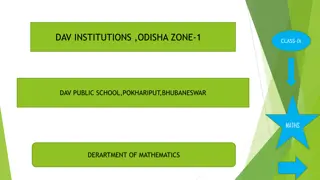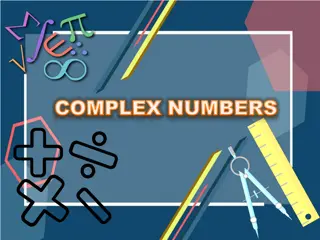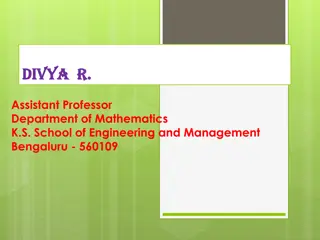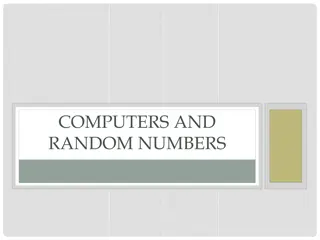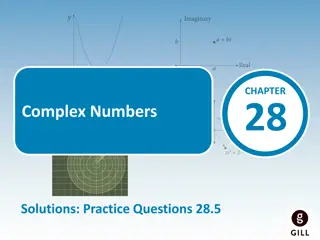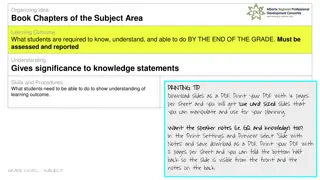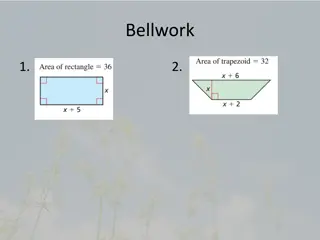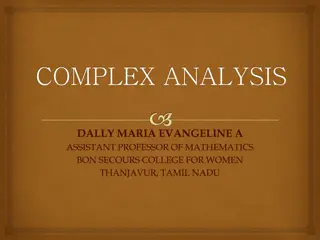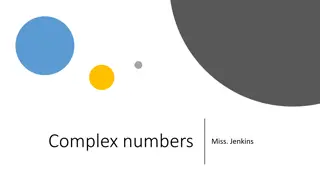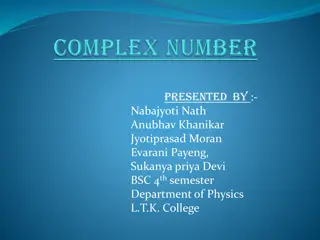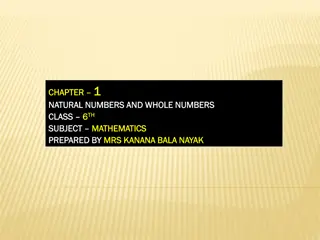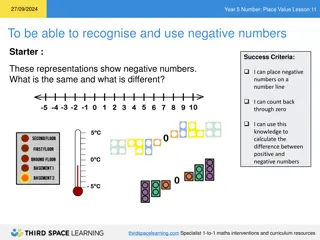Understanding Complex Numbers and Functions in Mathematics
Explore the concept of complex numbers, their operations like addition, subtraction, and multiplication, as well as De Moivre's theorem for raising complex numbers to powers. Dive into solving problems using complex numbers and understanding functions, algebra, and the remainder and factor theorems in mathematics.
Download Presentation

Please find below an Image/Link to download the presentation.
The content on the website is provided AS IS for your information and personal use only. It may not be sold, licensed, or shared on other websites without obtaining consent from the author. Download presentation by click this link. If you encounter any issues during the download, it is possible that the publisher has removed the file from their server.
E N D
Presentation Transcript
Mathematics NCV4
Chapter 1: Complex numbers WORK WITH COMPLEX NUMBERS The complex number system defines sums of real and imaginary numbers, a + bi, where a and b are real numbers: the imaginary unit is i a is called the real part bi is called the imaginary part. The real number system (R) together with the imaginary number system form the complex number system. www.futuremanagers.com
Chapter 1: Complex numbers (continued) ADDITION, SUBTRACTION, MULTIPLICATION OF COMPLEX NUMBERS When adding or subtracting terms in algebra, you add or subtract like terms. The same rule applies when you add or subtract complex numbers. To add or subtract complex numbers you can treat i as you would treat a variable. O multiply: Each part of the first complex number gets multiplied by each part of the second complex number. www.futuremanagers.com
Chapter 1: Complex numbers (continued) DE MOIVRE S THEOREM De Moivre s theorem is used to raise complex numbers to powers. This theorem provides a simple way to determine a power of a complex number in polar form. www.futuremanagers.com
Chapter 1: Complex numbers (continued) SOLVE PROBLEMS USING COMPLEX NUMBERS Just as you can have equations with real numbers you can have equations with complex numbers. There are several ways of solving simultaneous equations, the most common being by a combination of substitution (replacing) and elimination (to remove or to get rid of). To solve simultaneous equations, you need to find the values for x and y that will satisfy both equations. www.futuremanagers.com
Chapter 2: Functions and Algebra THE REMAINDER AND THE FACTOR THEOREMS The remainder and factor theorems are used to solve cubic equations and also to draw graphs. The remainder theorem is used to factorise polynomials of the third degree. (The remainder is the amount left over in a division operation when one quantity cannot be divided exactly by another. ) The factor theorem enables us to factorise polynomials of a degree higher than two. The factor theorem is a direct result of the remainder theorem. www.futuremanagers.com
Chapter 2: Functions and Algebra (continued) INVERSE GRAPHS OF FUNCTIONS Relations describe any relationship between the dependent (y) and the independent (x) variables. Functions are special kind of relations. An inverse function is a second relation that reverses the direction of the mapping produced by a first function. For an inverse to exist, the first function must produce a one-to-one correspondence. An inverse function can also be defined as the set of ordered pairs obtained by swapping the x- and y- elements of each ordered number pair in the original function. www.futuremanagers.com
Chapter 2: Functions and Algebra (continued) LINEAR PROGRAMMING Linear programming is used every day by people (for example in businesses and in industrial contexts) who are interested to know the most efficient way of carrying out a task or achieving a goal. Linear programming is the mathematical method used to find the best solution to problems that can be expressed in terms of linear equations, straight-line graphs and linear inequalities. It is used to achieve the best outcome, such as maximum profits or lowest costs and production levels. www.futuremanagers.com
Chapter 2: Functions and Algebra (continued) INSTANEOUS RATE OF CHANGE The derivative tells us the rate of change of one quantity to another at a particular point (instant). This is called the instantaneous rate of change. It has many applications in electricity, economics, population modelling, and so on. When a quantity is always changing in value, such as population, we use calculus (differentiation and integration) to model its behaviour. www.futuremanagers.com
Chapter 2: Functions and Algebra (continued) INTEGRATION This section involves analysing and representing mathematical and contextual situations using integrals, and finding areas under curves using integration rules. Integration is an important concept in mathematics. It is the inverse of differentiation. The term integral may also be called the antiderivative. Integrals and derivatives have numerous applications in science and engineering, for example, to calculate surface areas and to formulate physical laws of electrodynamics. www.futuremanagers.com
Chapter 3: Space, Shape and Measurement USE THE CARTESIAN CO-ORDINATE SYSTEM TO DERIVE AND APPLY EQUATIONS The formulae to find the equation to find the centre of a circle were derived using Pythagoras theorem or the distance formula. Often the equation of the circle with centre at (h; k) requires completing the square to write the equation in the standard form. www.futuremanagers.com
Chapter 3: Space, Shape and Measurement (continued) THE GEOMETRY OF STRAIGHT LINES The angle of a straight line is 180 . For perpendicular lines, adjacent supplementary angles are equal to 180 . For intersecting lines, adjacent supplementary angles are equal to 180 and vertically opposite angles are equal. For parallel lines cut by a transversal, corresponding and alternate angles are equal. www.futuremanagers.com
Chapter 3: Space, Shape and Measurement (continued) THE GEOMETRY OF TRIANGLES The sum of the interior angles is 180 . An equilateral triangle has all sides equal and all angles equal to 60 . An isosceles triangle has at least two equal sides with base angles equal. A right-angled triangle has one angle that is a right-angle. The side opposite the right-angle is the hypotenuse. The square of the hypotenuse is equal to the sum of the squares of the other two sides. The exterior angle of a triangle is equal to the opposite two interior angles. www.futuremanagers.com
Chapter 3: Space, Shape and Measurement (continued) THE GEOMETRY OF STRAIGHT LINES The geometry of straight lines can be defined in terms of angles. www.futuremanagers.com
Chapter 3: Space, Shape and Measurement (continued) TYPES OF ANGLES Type of angle Description Acute angle An angle less than 90 Right angle An angle equal to 90 Obtuse angle An angle greater than 90 , but smaller than 180 Straight line An angle equal to 180 Reflex angle An angle greater than 180 Revolution An angle equal to 360 Complementary angles Sum of angles equals 90 Supplementary angles Sum of angles equals 180 www.futuremanagers.com
Chapter 3: Space, Shape and Measurement (continued) GEOMETRY OF TRIANGLES A triangle is defined as a polygon with three angles and therefore three sides or edges, which are line segments. www.futuremanagers.com
Chapter 3: Space, Shape and Measurement (continued) TYPES OF TRIANGLES Type of triangle Description Scalene triangle Sides are all different lengths and all three angles different Isosceles triangle Two equal sides and the angles opposite the sides are also equal Equilateral triangle All three sides are equal and each angle measures 60 Acute-angled triangle All interior angles are less than 90 Obtuse-angled triangle One interior angle is more than 90 Right-angled triangle One interior angle is a right angle, that is, 90 www.futuremanagers.com
Chapter 3: Space, Shape and Measurement (continued) PROPERTIES OF TRIANGLES The exterior angle of a triangle is equal to the sum of the two opposite interior angles. The exterior angle of a triangle is equal to the sum of the two opposite interior angles. The Theorem of Pythagoras states that in a right-angled triangle the square of the hypotenuse is equal to the sum of the squares of the other two sides. www.futuremanagers.com
Chapter 3: Space, Shape and Measurement (continued) CIRCLE TERMS www.futuremanagers.com
Chapter 3: Space, Shape and Measurement (continued) MAJOR THEOREMS OF CIRCLES Theorem 1: If a line is drawn from the centre of a circle to the midpoint of a chord, that line is perpendicular to the chord. Conversely, if a line is drawn from the centre of the circle perpendicular to the chord, it bisects the chord. Theorem 2: If an arc subtends an angle at the centre of the circle and at any point on the circumference, the angle at the centre is twice the measure of the angle at the circumference. www.futuremanagers.com
Chapter 3: Space, Shape and Measurement (continued) MAJOR THEOREMS OF CIRCLES (CONT) Theorem 3: If the diameter of a circle subtends an angle at the circumference, the angle subtended is a right angle triangle. Conversely, if an angle subtended by a chord at a point on the circumference is a right angle, the chord is a diameter. www.futuremanagers.com
Chapter 3: Space, Shape and Measurement (continued) MAJOR THEOREMS OF CIRCLES (CONT) Theorem 4: Angles in the same segment of a circle are equal. Conversely, if a straight line subtends equal angles at two points on the same side of the straight line, the two points and the two end points of the straight line are concyclic. www.futuremanagers.com
Chapter 3: Space, Shape and Measurement (continued) MAJOR THEOREMS OF CIRCLES (CONT) Theorem 5: The opposite angles of a cyclic quadrilateral are supplementary. Conversely, if two opposite angles of a quadrilateral are supplementary, then quadrilateral is a cyclic quadrilateral www.futuremanagers.com
Chapter 3: Space, Shape and Measurement (continued) MAJOR THEOREMS OF CIRCLES (CONT) Theorem 6: An exterior angle of a cyclic quadrilateral is equal to the interior opposite angle. Conversely, if an exterior angle of a quadrilateral is equal to the interior opposite angle, the quadrilateral is cyclic. www.futuremanagers.com
Chapter 3: Space, Shape and Measurement (continued) MAJOR THEOREMS OF CIRCLES (CONT) Theorem 7: If a tangent to a circle is drawn, it is perpendicular to the radius at the point of contact. Conversely, if a line is drawn perpendicular to a radius at the point where the radius meets the circle, it is a tangent to the circle. Theorem 8: If two tangents are drawn from the same point outside a circle, they are equal in length. www.futuremanagers.com
Chapter 3: Space, Shape and Measurement (continued) MAJOR THEOREMS OF CIRCLES (CONT) Theorem 9: The angle between a tangent to a circle and a chord drawn from a point of contact, is equal to an angle in the alternate segment. Conversely, if the angle formed between a line that is drawn through the end point of a chord and the chord, is equal to the angle subtended by the chord in the alternate segment, the line is a tangent to the circle www.futuremanagers.com
Chapter 3: Space, Shape and Measurement (continued) COMPOUND ANGLES Compound angle identities: sin(? ?) = sin?.cos? sin?.cos? cos(? ?) = cos?.cos? sin?.sin? www.futuremanagers.com
Chapter 3: Space, Shape and Measurement (continued) COMPOUND ANGLES TO DERIVE CO-FUNCTIONS Co-functions, that is, (90 ): ??? 90 ? = ??? 90 .??? ? + ??? 90 .??? ? = 0.??? ? + 1.??? ? = ??? ? ???(90 ?) = ??? 90 .??? ? ??? ?.??? 90 = 1.??? ? ??? ?.0 = ??? ? ??? 90 ? =??? 90 ? cos 90 ? =???90 .???? ????.???90 90 .???? + ???90 .???? 1.???? ????.0 0.???? + 1.???? =???? ???? = www.futuremanagers.com
Chapter 3: Space, Shape and Measurement (continued) COMPOUND ANGLES TO DERIVE CO-FUNCTIONS (CONT) Co-functions, that is, (90 + ): ??? 90 + ? = ??? 90 .??? ? + ??? ?.??? 90 = 1.??? ? + ??? ?.0 = ??? ? cos(90 + ?) = cos90 .cos? sin90 .sin? = 0.cos? 1.sin? = sin? tan(90 + ?) =sin 90 + ? sin90 .cos? + sin?.cos90 ???90 .???? ???90 .???? 1.cos? + sin?.0 0.???? 1.???? = cos? ???? = = cos 90 + ? www.futuremanagers.com
Chapter 3: Space, Shape and Measurement (continued) DOUBLE ANGLE IDENTITIES From the compound angle identity sin(? + ?) = sin?.cos? + sin?.cos?,sin2? = sin(? + ?) = sin?.cos? + sin?.cos? = 2sin?.cos? Therefore: ??? 2? = 2??? ?.??? ? www.futuremanagers.com
Chapter 3: Space, Shape and Measurement (continued) DOUBLE ANGLE IDENTITIES (CONT) From the compound angle identitycos ? + ? = cos?.cos? sin? .sin?,cos2? = cos(? + ?) = cos?.cos? sin?.sin? = cos2 ? sin2? Therefore: cos2? = cos2 ? sin2 ? www.futuremanagers.com
Chapter 3: Space, Shape and Measurement (continued) DOUBLE ANGLE IDENTITIES (CONT) but cos2? in terms of cos?, cos2? = cos2? sin2 ? = cos2 ? (1 cos2 ?) = 2cos2 ? 1 Therefore: cos2? = 2cos2 ? 1 www.futuremanagers.com
Chapter 3: Space, Shape and Measurement (continued) DOUBLE ANGLE IDENTITIES (CONT) but cos2? in terms of sin?, cos2? = cos2? sin2? = (1 sin2?) sin2? = 1 2sin2 ? Therefore: cos2? = 1 2sin2? www.futuremanagers.com
Chapter 3: Space, Shape and Measurement (continued) THE SINE RULE The sine and cosine rules are applied to non-right-angled triangles. The sine rule is used for non-right-angled triangles where: Two sides and one non-included angle are given Two angles and one side are given www.futuremanagers.com
Chapter 3: Space, Shape and Measurement (continued) THE COSINE RULE The cosine rule is used for non-right-angled triangles where: Two sides and one included angle are given. Three sides are given. www.futuremanagers.com
Chapter 4: Data Handling DATA ANALYSIS USING VARIOUS TECHNIQUES A sample is defined as a subset of items drawn from the population, that represents every possible item. Graphical representations and numerical summaries that are consistent with the data, and clear and appropriate to the situation and target audience. A frequency table is the figure that represents the number of times a specific incident occurred. Bar graphs are a good way of representing discrete data. www.futuremanagers.com
Chapter 4: Data Handling (continued) DATA ANALYSIS USING VARIOUS TECHNIQUES (CONT) A bar graph that comprises two or more components is called a compound bar graph. The stem and leave plot is similar to a histogram, in that it also presents data in a graphical format. A histogram is a graphical representation of grouped data in terms frequency. Frequency polygons are very similar to histograms and can therefore be drawn from histograms. www.futuremanagers.com
Chapter 4: Data Handling (continued) DATA ANALYSIS USING VARIOUS TECHNIQUES (CONT) Pie charts are circular charts divided into sectors. These sectors represent the proportion of the quantities. Line graphs are used to show how a dependent variable changes in terms of an independent variable. A broken line graph relates specifically to data in which the independent variable is time. The box and whisker plot is a representation of the five number summary. www.futuremanagers.com
Chapter 4: Data Handling (continued) DATA ANALYSIS USING VARIOUS TECHNIQUES (CONT) The ogive curve is a graphical representation of the cumulative frequency distribution table (or ogive). The main purpose of the ogive is to answer questions of a more than or less than nature. www.futuremanagers.com
Chapter 4: Data Handling (continued) NUMERICAL SUMMARIES OF DATA Measure of central tendency describes the mean, median and mode. Measure of dispersion describes the range, quartiles, interquartile range, semi-interquartile range. These measures are rank-sensitive, therefore the data first need to be arranged in ascending order. www.futuremanagers.com
Chapter 4: Data Handling (continued) USE VARIANCE AND REGRESSION ANALYSIS TO INTERPOLATE AND EXTRAPOLATE BIVARIATE DATA A sample variance is described as the measure of dispersion within a set of sample data. The sample variance is defined as the sum of the squared deviations from their mean divided by one less than the number of observations in the data set. A standard deviation is also a measure of the spread or dispersion of a data set. The standard deviation is calculated by taking the square root of the variance. www.futuremanagers.com
Chapter 4: Data Handling (continued) PROBABILITY TERMINOLOGY The sample space, S, is the set of all possible outcomes of an experiment. An event is any subset of the sample space. Two events, A and B, are statistically dependent if the one event affects the outcome of the other event. Two events, A and B, are statistically independent if there is no influence of one event on the other event. www.futuremanagers.com
Chapter 4: Data Handling (continued) PROBABILITY TERMINOLOGY (CONT) Two events, A and B, are mutually exclusive if they cannot both have a successful outcome at the same time. Two events, A and B, are mutually inclusive if they happen at the same time, that is, successful outcomes at the same time. www.futuremanagers.com
Chapter 5: Financial Mathematics HIRE PURCHASE Hire purchase is a system of purchasing a product where the customer takes possession of the product on payment of a deposit and completes the purchase by paying a series of regular instalments. The customer only becomes the owner of the product once the final instalment has been paid. For a hire purchase loan the interest is computed at a simple interest rate, and it is only applicable to the amount owing. www.futuremanagers.com
Chapter 5: Financial Mathematics (continued) INFLATION Inflation refers to an average percentage increase in the price of goods from year to year. This progressive increase of prices is often brought about by an expansion in demand or autonomous increases in costs. As a result of these average percentage increases from year to year, the compound growth formula will be utilised. www.futuremanagers.com



